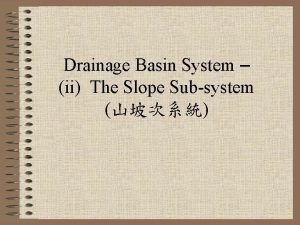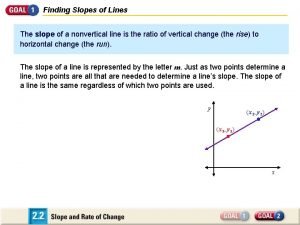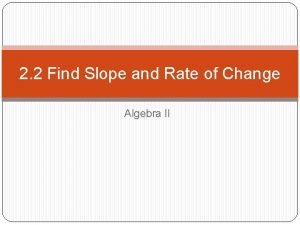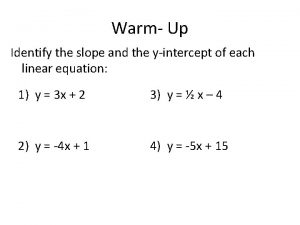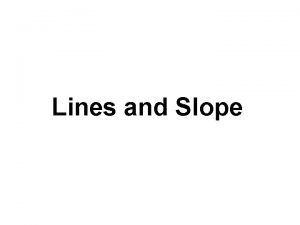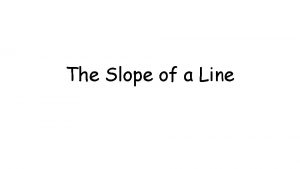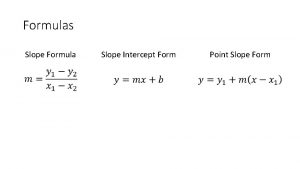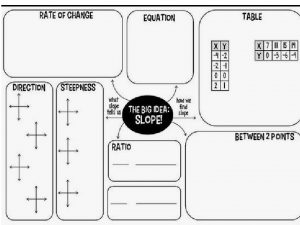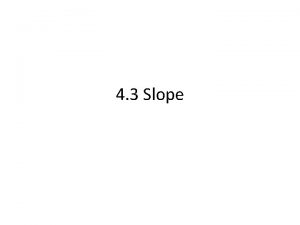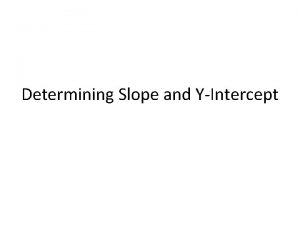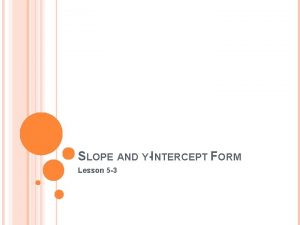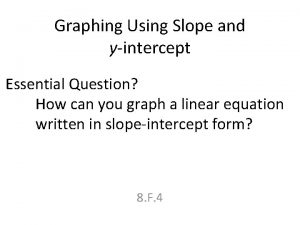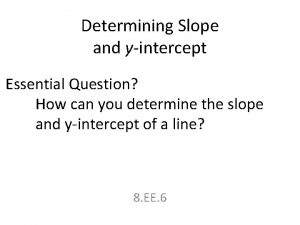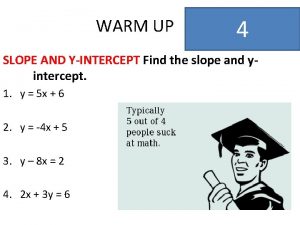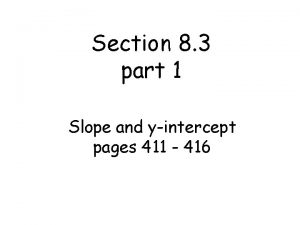EXAMPLE 1 Identify slope and yintercept Identify the






















- Slides: 22

EXAMPLE 1 Identify slope and y-intercept Identify the slope and y-intercept of the line with the given equation. 1. y = 3 x + 4 2. 3 x + y = 2 SOLUTION a. The equation is in the form y = m x + b. So, the slope of the line is 3, and the y-intercept is 4. b. Rewrite the equation in slope-intercept form by solving for y.

EXAMPLE 1 Identify slope and y-intercept 3 x + y = 2 y = – 3 x + 2 Write original equation. Subtract 3 x from each side. ANSWER The line has a slope of – 3 and a y-intercept of 2.

EXAMPLE 1 for Example 1 Identify slope and y-intercept GUIDED PRACTICE Identify the slope and y-intercept of the line with the given equation. 1. y = 5 x – 3 SOLUTION The equation is in the form y = mx + b. So, the slope of the line is 5, and the y-intercept is – 3.

EXAMPLE 1 for Example 1 Identify slope and y-intercept GUIDED PRACTICE Identify the slope and y-intercept of the line with the given equation. 2. 3 x – 3 y = 12

EXAMPLE 1 for Example 1 Identify slope and y-intercept GUIDED PRACTICE SOLUTION Rewrite the equation in slope-intercept form by solving for y. Write original equation. 3 x – 3 y = 12 Rewrite original equation. 3 x – 12 = 3 y Divide 3 by equation. y = 3 x + 12 3 Simplify. y =x – 4 ANSWER The line has a slope of – 1 and a y-intercept of – 4.

EXAMPLE 1 for Example 1 Identify slope and y-intercept GUIDED PRACTICE Identify the slope and y-intercept of the line with the given equation. 3. x + 4 y = 6

EXAMPLE 1 for Example 1 Identify slope and y-intercept GUIDED PRACTICE SOLUTION Rewrite the equation in slope-intercept form by solving for y. Write original equation. x + 4 y = 6 4 y = – x + 6 y= – x + 6 4 –x 6 = 4 + 4 Rewrite original equation. Divide 3 by equation. Simplify. ANSWER – The line has a slope of 1 and a y-intercept of 1 1. 4 2

EXAMPLE 2 Graph an equation using slope-intercept form Graph the equation 2 x + y = 3. SOLUTION STEP 1 Rewrite the equation in slope-intercept form. y = – 2 x + 3

EXAMPLE 2 Graph an equation using slope-intercept form STEP 2 Identify the slope and the y-intercept. m= – 2 and b =3 STEP 3 Plot the point that corresponds to the y-intercept, (0, 3). STEP 4 Use the slope to locate a second point on the line. Draw a line through the two points.

EXAMPLE 3 Change slopes of lines ESCALATORS To get from one floor to another at a library, you can take either the stairs or the escalator. You can climb stairs at a rate of 1. 75 feet per second, and the escalator rises at a rate of 2 feet per second. You have to travel a vertical distance of 28 feet. The equations model the vertical distance d (in feet) you have left to travel after t seconds. Stairs: d = – 1. 75 t + 28 Escalator: d = – 2 t + 28

EXAMPLE 3 Change slopes of lines a. Graph the equations in the same coordinate plane. b. How much time do you save by taking the escalator? SOLUTION a. Draw the graph of d = – 1. 75 t + 28 using the fact that the d-intercept is 28 and the slope is – 1. 75. Similarly, draw the graph of d = – 2 t + 28. The graphs make sense only in the first quadrant.

EXAMPLE 3 b. Change slopes of lines The equation d = – 1. 75 t + 28 has a t-intercept of 16. The equation d = – 2 t + 28 has a t-intercept of 14. So, you save 16 – 14 = 2 seconds by taking the escalator.

EXAMPLE 2 Graph an equation for Examples 2 and 3 using slope-intercept form GUIDED PRACTICE 4. Graph the equation y = – 2 x + 5. SOLUTION STEP 1 Identify the slope and the y- intercept. m= – 2 and b =5 STEP 2 Plot the point that corresponds to the y-intercept, (0, 5). STEP 3 Use the slope to locate a second point on the line. Draw a line through the two points.

EXAMPLE 2 Graph an equation for Examples 2 and 3 using slope-intercept form GUIDED PRACTICE 5. WHAT IF? In Example 3, suppose a person can climb stairs at a rate of 1. 4 feet second. How much time does taking the escalator save? Stairs: d = – 1. 4 t + 28 Escalator: d = – 2 t + 28 SOLUTION a. Draw the graph of d = – 1. 4 t +28 using the fact that the d-intercept is 28 and the slope is – 1. 4. Similarly, draw the graph of d = – 2 t + 28. The graphs make sense only in the first quadrant.

EXAMPLE 3 for Examples 2 and 3 Change slopes of lines GUIDED PRACTICE b. The equation d = – 1. 4 t + 28 has a t-intercept of 20. The equation d = – 2 t + 28 has a t-intercept of 14. So, you save 20 – 14 = 6 seconds by taking the escalator.

EXAMPLE 4 Change intercepts of lines TELEVISION A company produced two 30 second commercials, one for $300, 000 and the second for $400, 000. Each airing of either commercial on a particular station costs $150, 000. The cost C (in thousands of dollars) to produce the first commercial and air it n times is given by C = 150 n + 300. The cost to produce the second air it n times is given by C = 150 n + 400. a. Graph both equations in the same coordinate plane.

EXAMPLE 4 Change intercepts of lines b. Based on the graphs, what is the difference of the costs to produce each commercial and air it 2 times? 4 times? What do you notice about the differences of the costs? SOLUTION a. The graphs of the equations are shown. b. You can see that the vertical distance between the lines is $100, 000 when n = 2 and n = 4. The difference of the costs is $100, 000 no matter how many times the commercials are aired.

EXAMPLE 5 Identify parallel lines Determine which of the lines are parallel. Find the slope of each line. – 1– 0 – 1 1 Line a: m = = – 3 = – 1– 2 3 Line b: m = – 3 – (– 1 ) 0 – 5 – (– 3) Line c: m = – 2 – 4 – 2 2 = – 5 = 5 – 2 1 = – 6 = 3 ANSWER Line a and line c have the same slope, so they are parallel.

EXAMPLE 5 for Examples Identify parallel lines 4 and 5 GUIDED PRACTICE 6. WHAT IF? In Example 4, suppose that the cost of producing and airing a third commercial is given by C = 150 n + 200. Graph the equation. Find the difference of the costs of the second commercial and the third.

EXAMPLE 4 GUIDED PRACTICE for Examples 4 and 5 SOLUTION a. The graph of the equation are shown. b. You can see that when n = 2 , C is $500, 000 and when n = 4, C is $900, 000. This cost is $200, 000 less no matter how many times the commercials are aired.

EXAMPLE 5 for Examples Identify parallel lines 4 and 5 GUIDED PRACTICE 7. Determine which lines are parllel: line a through ( -1, 2) and (3, 4); line b through (3, 4) and (5, 8); line c through (-9, -2) and (-1, 2). SOLUTION Find the slope of each line. 4– 2 2 1 Line a: m = 3 –(1) = 3+1 = 2 8– 4 Line b: m = 5 – 3 = – 2 = 2 2 – (– 2) 2+2 Line c: m = – 1 – (– 9) =– 1+ 9 4 = 8 1 = 2

EXAMPLE 5 for Examples Identify parallel lines 4 and 5 GUIDED PRACTICE ANSWER Line a and line c have the same slope, so they are parallel.
 Yintercept definition
Yintercept definition Slope decline and slope retreat
Slope decline and slope retreat Point-slope form definition geometry
Point-slope form definition geometry Slope review classifying slope
Slope review classifying slope Slope review classifying slope
Slope review classifying slope Hình ảnh bộ gõ cơ thể búng tay
Hình ảnh bộ gõ cơ thể búng tay Ng-html
Ng-html Bổ thể
Bổ thể Tỉ lệ cơ thể trẻ em
Tỉ lệ cơ thể trẻ em Voi kéo gỗ như thế nào
Voi kéo gỗ như thế nào Glasgow thang điểm
Glasgow thang điểm Hát lên người ơi alleluia
Hát lên người ơi alleluia Môn thể thao bắt đầu bằng từ đua
Môn thể thao bắt đầu bằng từ đua Thế nào là hệ số cao nhất
Thế nào là hệ số cao nhất Các châu lục và đại dương trên thế giới
Các châu lục và đại dương trên thế giới Công thức tiính động năng
Công thức tiính động năng Trời xanh đây là của chúng ta thể thơ
Trời xanh đây là của chúng ta thể thơ Cách giải mật thư tọa độ
Cách giải mật thư tọa độ 101012 bằng
101012 bằng Phản ứng thế ankan
Phản ứng thế ankan Các châu lục và đại dương trên thế giới
Các châu lục và đại dương trên thế giới Thể thơ truyền thống
Thể thơ truyền thống Quá trình desamine hóa có thể tạo ra
Quá trình desamine hóa có thể tạo ra

